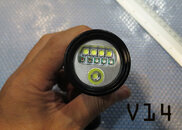thanks. It's still listed, but I'm not finding a US distributer so I don't know what that would cost me.
See
TillyTec - ein einzigartiges Lampensystem - contact
BTW, the TillyTec torch
TillyTec - ein einzigartiges Lampensystem - MPL 500/UV Light has "UV" in its name but it's actually a broadband LED in the violet range (ca. 400-430 nm), last thing I know (might have changed in the meantime if Tilly did start to listen to Horst Grunz).
I would be carefull with ultra bright UV lights. They can damage your eyes in no time without being notifiable. And what is bad for your eyes is very likely bad for underwater creatures, too. Moreover the fluro effect is not the same as with 450nm blue light - no matter how "bright" your UV light is.
See
Ultraviolet versus blue excitation light
My guess is you are trying to do something physically impossible: get a UV light to go 40 ft, and have the fluorescence go 40 ft to get back to you to see.
I know of a true UV (365 nm) torch with 46 Watts and a radiant flux of about 6.5 Watts (UV LEDs really are not that efficient!), see
Picasa Web Albums - O.St. Bey. - How to build ...
Just the UV LEDs alone (4 quadruple LEDs from Nichia) cost more than 400 Euros!
And this is the result you can get with it:
FluoMedia.org: Videos
As you can see, the colours are relatively dull compared to blue excitation light (see e.g.
http://www.fluomedia.org/gallery/videos/?8), and one has to get really close with UV to have any significant fluorescence effect.
See also
http://www.fluomedia.org/gallery/videos/?3 - the fluorescent beacons/buoys were positioned at 50 cm, 1m and 2m distance from the block of corals.
With UV light, one can only see fluorescence of the corals at less than 50 cm! And this was in the Red Sea, with excellent visibility!
So 40 feet distance is completely out of the question. Also because UV light is quickly converted into visible light by fluorescence of the water itself (due to dissolved organic matter, such as fulvic and humic acids from decaying organic matter, runoff from land, etc.).
See
http://www.fluomedia.org/img/UV_Beam.jpg (torch with 365 nm).
Even with blue light (for which water is most transparent!) 40 feet is illusory. Also because the colours of the fluorescent response are absorbed by water much more quickly than the blue excitation light.
This is the reason Tillytec is offering a blue light instead of UV, too. There is no way around a blue light filter when trying to see ALL the colors..and is it better for creatures u want to see.
See
Effects of UV or blue light on marine life
Maybe it would be worth trying a light in the visible spectrum first. In that case, I could probably just put a blue filter on my primary and pick up a yellow filter for my mask. That would be a much cheaper method and the light would be plenty bright.
Note that torches and filters need to have tightly coupled optical properties for optimal results.
See
Mixing equipment from different vendors and
Barrier Filters as well as
Comparison without and with dichroic filter for results you can get when the filters are not optimally chosen.
Don't forget that a 'filter' removes light. Your super-bright white light flashlight may not produce as much blue light (after filtering) than a dedicated blue LED light.
See
White light with filter versus dedicated blue light - the short version is that you lose about 80% of your light output if you filter a white light torch with a blue filter.
Moreover, using a single dichroic filter (which are more precise than absorption filters and don't heat up) may give you unsatisfactory results; see the bottom two images from the block of six images at
Comparison sandwiched strobe filters; left is a single dichroic filter, right is a special "sandwich" filter.
You can see that the single dichroic filter leaks white light to an unacceptable degree.






